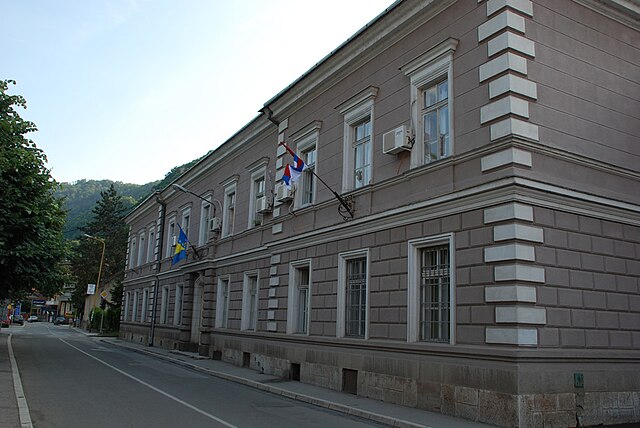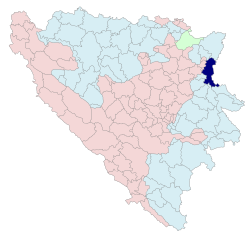Top Qs
Timeline
Chat
Perspective
Zvornik
City in Bosnia and Herzegovina From Wikipedia, the free encyclopedia
Remove ads
Zvornik (Serbian Cyrillic: Зворник, pronounced [zʋɔ̌rniːk]) is a city in Republika Srpska, Bosnia and Herzegovina. In 2013, it had a population of 58,856 inhabitants. Zvornik is located on the Drina River, on the eastern slopes of Majevica mountain, at the altitude of 146m.[1]
This article needs additional citations for verification. (March 2012) |
The town of Mali Zvornik ("Little Zvornik") lies directly across the river in Serbia. Kula Grad, a village that is part of Zvornik municipality, has a Middle Age fort, Zvornik fortress, built in the 12th century.
Remove ads
History
Summarize
Perspective
Zvornik is first mentioned in 1410, although it was known as Zvonik ("bell tower") at that time. The town's geographic location has made it an important trade link between Bosnia and the east. For instance, the main road connecting Sarajevo and Belgrade runs through the city. The medieval fort known as Kula grad was built in the early 7th century and still stands on the Mlađevac mountainous range overlooking the Drina Valley.
Ottoman rule

During the Ottoman period, Zvornik was the capital of the Sanjak of Zvornik (an administrative region) within the Eyalet of Bosnia. This was primarily the case because of the city's crucial role in the economy and the strategic importance of the city's location. The Sanjak of Zvornik was one of six Ottoman sanjaks with most developed shipbuilding (besides the sanjaks of Vidin, Nicopolis, Požega, Smederevo and Mohač).[2] In 1806, Zvornik was home to Mehmed-beg Kulenović.[citation needed]
Stojan Čupić (also known as Zmaj od Noćaja), one of the leaders of the First Serbian Uprising, was captured and murdered by the Turks in Zvornik in 1815. He was initially buried near the road from Zvornik to Tuzla, and his remains were moved to Salaš Noćajski in 1988.[3]
World War II
Ustasha troops of the fascist Independent State of Croatia occupied Zvornik, along with most of Bosnia, in April 1941. The town was liberated in July 1943 by the 1st Proletarian Brigade during the Battle of Zvornik.[citation needed]
Bosnian war
During the Bosnian War (1992–1995) Zvornik's Bosniak population was expelled. The military attack of paramilitary groups that came from Serbia on Zvornik Bosniaks commenced on 8 April 1992.[4] During April 1992, many European news stations daily reported Serb armed attacks and mass killings of the Bosniak population of Zvornik and the surrounding villages.[5]
On 19 May 1992, combined JNA, Serb paramilitary and Arkan's Tigers took control of Zvornik and Mali Zvornik.[4] The suburbs of Karakaj and Čelopek were places of prisons where hundreds of local Bosniaks were killed. The remaining Bosniaks and non-Serbs were relegated to concentration camps and detention facilities throughout the area.[4] During the war Serb forces destroyed mosques in and around the city.[citation needed]
- Photograph of Stećci in Zvornik
- Zvornik in 1897
- Local policemen and US military personnel on their way to check a post-Dayton resettlement effort
Remove ads
Settlements
Aside from the city proper area of Zvornik, the municipality comprises the following settlements:
- Androvići
- Baljkovica
- Baljkovica Donja
- Boškovići
- Buložani
- Čelopek
- Cer
- Divič
- Donja Pilica
- Donji Lokanj
- Drinjača
- Dugi Dio
- Đevanje
- Đulići
- Glodi
- Glumina
- Goduš
- Gornja Pilica
- Gornji Lokanj
- Grbavci Donji
- Grbavci Gornji
- Gušteri
- Jardan
- Jasenica
- Jusići
- Kamenica Donja
- Kamenica Gornja
- Kiseljak
- Kitovnice
- Klisa
- Kostijerevo
- Kozluk
- Kraljevići
- Križevići
- Kučić Kula
- Kula Grad
- Liješanj
- Liplje
- Malešići
- Marčići
- Međeđa
- Mehmedići
- Nezuk
- Novo Selo
- Pađine
- Paljevići
- Petkovci
- Potočani
- Rastošnica
- Roćević
- Rožanj
- Sapna
- Skočić
- Snagovo
- Snagovo Donje
- Snagovo Gornje
- Sopotnik
- Šepak Donji
- Šepak Gornji
- Šetići
- Tabanci
- Trnovica
- Tršić
- Ugljari
- Vitinica
- Vrela
- Zaseok
- Zelinje



Remove ads
Demographics
Population
Ethnic composition
Remove ads
Economy


The table shows the number of registered people employed in legal entities by their core activity in 2018:[6]
Remove ads
Culture



The Cultural Summer of Zvornik (Zvorničko kulturno ljeto) is an annual event held in the first week of August, usually for six days. Its main objective is to become a traditional cultural event which will open the doors of Zvornik for recognized cultural values.
The festival was first held in August 2001 as a local event and has grown to be one of the biggest festivals in the Balkans.
In 2007, famous singers such as Neda Ukraden and Sandi Cenov participated, but in 2008 theis festival featured some of the most notable stars from former Yugoslavia, like Željko Joksimović, Hari Mata Hari, Van Gogh and Marinko Rokvić. There is also a regatta on the river Drina, a fun marathon and many cultural events and competitions during day and night.[7]
Remove ads
International co-operation
Zvornik is twinned with:
Other friendships and cooperations, protocols, memorandums:
Sport
The local football clubs, FK Drina Zvornik and ŽFK Drina Zvornik, play in the First League of the Republika Srpska.[10] Members of the First league of Republika Srpska also are volleyball and handball clubs Zvornik.
Notable people
- Seka Aleksić, singer
- Ermin Bičakčić, footballer
- Rade Đokić, footballer
- Amer Hrustanović, sports wrestler, European medallist
- Said Husejinović, footballer
- Goran Ikonić, basketball player
- Zlatko Junuzović, Austrian footballer
- Samir Muratović, footballer
- Nada Obrić, singer
- Denis Omerbegović, footballer
- Borisav Pisić, athlete
- Sejad Salihović, footballer
Remove ads
See also
References
External links
Wikiwand - on
Seamless Wikipedia browsing. On steroids.
Remove ads









